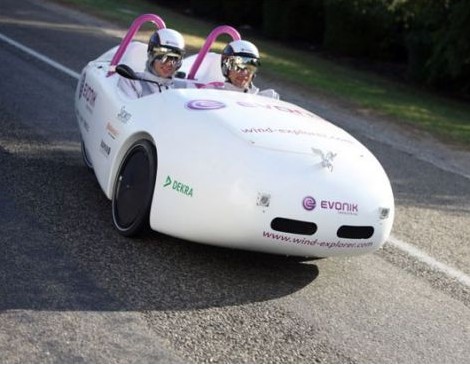
The “wind detector†is a lightweight car that weighs only about 220 kilograms and has enough space for two occupants. The body is egg-shaped, made of carbon fiber material, and the frame is made of aluminum. The four tires are custom-made bicycle tires.
Beijing February 21 news, German engineers Dirk Gion and Stefan Semmer have recently developed a new energy vehicle driven by wind energy and completed an amazing 3,000 miles in Australia (about 4828). (km) The test trip distance, thus creating three new records, and zero emissions, costing only $ 13.5.
This new energy car is called Wind Detector. On January 26, two German engineers, Dirk Giang and Stefan Semmer, drove “wind detectors†from Perth, Western Australia, and arrived in Sydney 18 days later. This test trip created three records: this is the first time that wind-driven travel across Australia, and the distance of 3,000 miles (approximately 4828 kilometers) is the longest total distance accomplished by wind-driven land transport. Within 36 hours, the furthest distance since the successful development was achieved.
The “wind detector†is a lightweight car that weighs only about 220 kilograms and has enough space for two occupants. The body is egg-shaped, made of carbon fiber material, and the frame is made of aluminum. The four tires are custom-made bicycle tires, which reduce drag.
The car is equipped with a 8 kilowatt-hour lithium-ion battery pack. However, the researchers did not connect the battery pack to the Australian grid for charging. They used bamboo to make a telescoping tubular antenna about 20 feet (about 6 meters) long, with a wind turbine on top of the antenna. Although it takes about half an hour to erect the antenna, this antenna can charge the car's battery pack at night when the driver is resting.
During the daytime, especially when travelling through the Naleb Plain in Australia and Australia, the car may experience strong winds, so the researchers used a paragliding kite to store electricity. Even in the absence of wind, this car can be connected to the Australian grid for charging. Although this appears to be suspected of fraud, the total electricity bill used throughout the trip is only $ 13.5.
Despite the good results of the test trip, Dirk Gion and Stefan Semmer are also very clear that their small car space and bulky turbine antenna may not represent the future direction of the car. However, zero emissions through travel are of great significance, which may promote the development of eco-friendly automotive technology in the future.
The researchers said, "There is enough clean energy on the earth to drive us everywhere. We only need to study how to capture this energy."